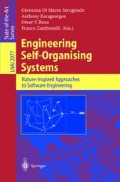Abstract
In this paper we present a genetic algorithm-based approach towards designing self-assembling objects comprised of square smart blocks. Each edge of each block can have one of three polarities (+1, -1 or 0) which defines how blocks stick together – opposite polarities attract, like polarities repel, and a 0 face neither attracts nor repels. In addition to this property, the block contains an internal state machine which can change the polarity of any number of its sides following the detection of an ”event” (for example, two blocks sticking or unsticking). The aim of this work is to evolve block parameters and rule sets of the state machine which allow the self-assembly of desired basic structures that can be used as primitive building blocks for the assembly of more complicated objects. We detail a genetic algorithm-based approach that can be used to evolve the rule sets of interaction for a number of interacting blocks, so that the final shape or states of a structure formed by the blocks can approximate some target shapes or satisfy some global goals. We have assumed a list of simple identical properties for each block, and observed that a great diversity of complex structures can be achieved.
Access this chapter
Tax calculation will be finalised at checkout
Purchases are for personal use only
Preview
Unable to display preview. Download preview PDF.
References
Goldberg, D.E.: Genetic algorithms in search, optimisation, and machine learning. Addison-Wesley Publishing Company, Inc., Reading (1989)
Wolfram, S. (ed.): Theory and Application of Cellular Automata. World Scientific, Singapore (1986)
Garis, H.: Dynamic, Genetic, and Chaotic Programming. In: Soucek, B. and the IRIS Group (ed.) Artificial Embryology: The Genetic Programming of an Artificial Embryo, Wiley, Chichester (1992)
Whitesides, G., et al.: Mesoscale Self-Assembly of Hexagonal Plates Using Lateral Capillary Forces: Synthesis Using the ’Capillary Bond’. J. Am. Chem. Soc. 121, 5373–5391 (1999)
Whitesides, G., et al.: Three-Dimensional Mesoscale Self-Assembly. J. Am. Chem. Soc. 120, 8267–8268 (1998)
Whitesides, G., et al.: Design and Self-Assembly of Open, Regular, 3D Mesostructures. Science 284, 948–951 (1999)
Raguse, B.: Self-assembly of Hydrogel Mesoblocks, personal communication. CSIRO (2002)
Bojinov, H., Casal, A., Hogg, T.: Multiagent Control of Self-reconfigurable Robots. In: Fourth International Conference on Multi Agent Systems, Boston, Massachusetts (2000)
Author information
Authors and Affiliations
Editor information
Editors and Affiliations
Rights and permissions
Copyright information
© 2004 Springer-Verlag Berlin Heidelberg
About this paper
Cite this paper
Guo, Y., Poulton, G., Valencia, P., James, G. (2004). Designing Self-Assembly for 2-Dimensional Building Blocks. In: Di Marzo Serugendo, G., Karageorgos, A., Rana, O.F., Zambonelli, F. (eds) Engineering Self-Organising Systems. ESOA 2003. Lecture Notes in Computer Science(), vol 2977. Springer, Berlin, Heidelberg. https://doi.org/10.1007/978-3-540-24701-2_6
Download citation
DOI: https://doi.org/10.1007/978-3-540-24701-2_6
Publisher Name: Springer, Berlin, Heidelberg
Print ISBN: 978-3-540-21201-0
Online ISBN: 978-3-540-24701-2
eBook Packages: Springer Book Archive

